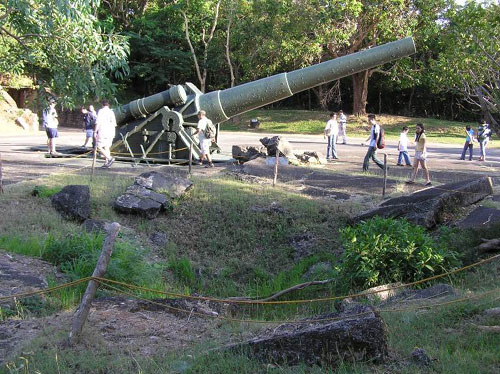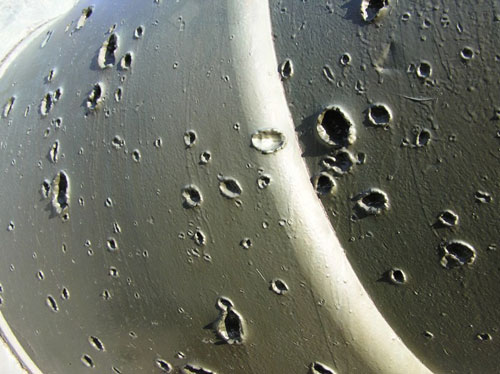


- Meteorites For Sale - Found A Meteorite? - Monthly Favourite - Meteorite Information - Classification List - Meteorite Collection - Media Centre - Home - Search - Site Map - Contact |
|
Sikhote-Alin - 32.8g & 11.9g Oriented Individuals with a Surface 'Impact Pit/Crater' This is a specimen from the famous Sikhote-Alin fall. In View 1 & 2 you can clearly see what looks like an 'Impact Pit/Crater' which measures 12mm x 11mm in diameter. This feature has formed at some stage during passage through Earths atmosphere as there is fusion crust inside. You can clearly see how the metal has been rolled over by an intense force. This meteorite also shows clear signs of orientation with a heavy roll-over lip on the flat section in View 3 and a small lip also at the end of the point. The second specimen is an 11.9g highly oriented meteorite. The leading side is relatively rounded and flat (View 4) while the trailing side is jagged and highly irregular. Around the edge of the meteorite are some flow lines also indicating directional orientation. It is on the rear that the small impact crater is found measuring 12mm x 10mm in diameter. It is not quite as smoothly formed as the 32.8g piece with the bottom of the pit being a little rougher and coarse. There are a number of different theories on how these features were formed of which some are presented in the abstract below. However, from looking at these two specimens it could be plausible to consider that when the Sikhote-Alin meteor exploded in the atmosphere it sprayed small fragments of iron at high velocity in every direction. These fragments would have been travelling like a bullet and any pieces in front of this main bolide directly in the path may have been hit. So if these small oriented meteorites were stabilised in this position it is possible that the rear trailing edges were hit by these high speed projectiles forming the impact pit/craters. This theory may also explain the presence of fusion crust within the pits as the pieces potentially had enough time to re-fuse after the projectile impact. This may also explain the lack of pits on more ablated surfaces such as the leading sides. If these pieces were hit when stationary on the ground, one might expect to see a lack of fusion crust in these pits. Also, pieces small enough to create a crater in another specimen would doubtfully have retained the necessary velocity by the time it reached the ground. Both of these specimens are part of the Meteorites Australia Collection. Update (March 2007): A reader of this page was very kind and sent me through a couple of photographs of damage caused to a World War II gun on Corregidor Island in the Philippines. The photos showing the damage are at the bottom of this page and bare a striking similarity to the impact pits found on some of the Sikhote-Alin specimens.
MAPS Supplement - The extract below explains one theory behind the formation of the 'impact pit/crater' feature. The full extract is available for download below.
MAPS 33-4, Supplement, 1998, p. A101: Impact-produced surface craters on Sikhote-Alin irons J.F. McHone1 and M. Killgore2 1Department of Geology, Arizona State University, Tempe AZ 85287-1404, USA 2Southwest Meteorite Laboratory, P.O. Box 95, Payson AZ 85547, USA. Introduction: Recent collecting expeditions into the Sikhote-Alin strewnfield have produced several individual and fragmented irons decorated with round-floored circular depressions surrounded by high-relief rims. Previous reports attribute most delicate surface features to aerodynamic sculpturing, effervescence of volatile components, or plucking of xenoliths. We interpret some of these features as impact craters sustained during the final moments of a specimen in flight. Background: On the morning of February 12, 1947, a brilliant fireball appeared in the clear sky over the Sikhote-Alin Mountains of eastern Siberia and, in less than 10 s, more than 50 tons of Fe meteorites slammed into uninhabited, snow-covered taiga forest. Formal expeditions began arriving almost immediately so that, over the next several years, more than 100 impact pits and craters had been charted, more than 30 tons of pristine irons had been collected, and a uniquely preserved, bountiful collection of cosmic material had become accessible for systematic scientific scrutiny [1,2]. Breakup and Fusion: The original Sikhote-Alin lron bolide, a coarsest octahedrite, began fragmenting high within the atmosphere along weaker internal planes defined by crystal boundaries. Recovered specimens occur mostly in three distinct geomorphic forms: (1) larger masses bounded by recognizable geometric planes and usually with defined regmaglypts; (2) twisted and jagged, shrapnel-like fragments with occasional regmaglypts or partial fusion crusts; and most commonly, (3) small, irregularly shaped individuals completely sheathed in a distinct high-gloss metallic fusion crust. Fusion crusts on all geomorphic forms commonly are decorated with delicately sculptured patterns, which include swirls of grooves and ridges, adhered or "spattered" metal beads, patches of scoriaceous froth and bubbles, and occasional pits or shallow holes with angular walls. A thick ground cover of snow, estimated to be at least 60 cm deep during the impact event, has been credited with cushioning the impact landing of smaller pieces and preserving their delicate surfaces. Most of these features are readily attributed to processes accompanying high-velocity atmospheric flow, including erosion of weaker components, frictional heat, volatilization, and plucking of single crystals. Impact Craters: During an examination of newly available, small (about 100 g) individual and fragmented Sikhote-Alin irons we have observed an unreported type of surface morphologic feature. Solitary, round-floored circular depressions 1-8 mm in diameter and ringed by high-relief rims occur on fusion-crusted individuals and on at least one shrapnel fragment. We interpret these features as impact craters resulting from high-velocity collisions between meteoritic particles during the latest stages of atmospheric flight. Although crater-like bubbles might develop within a fusion crust, during skin heating by atmospheric friction, craters emplaced on fusion-free shrapnel fragments had to have formed later, after atmospheric penetration had already violently disrupted a larger body. Local conditions during the Sikhote-Alin event included thousands of Fe projectiles infalling into an environment already populated with high-speed Fe and rock ejecta fragments from craters still being formed on the ground. References: [1] Krinov E.L. (1966) Giant Meteorites (Pergamon Press, 397 pp.). [2] Krinov E.L. (1960) Principles of Meteorites (Pergamon Press, 535 pp.).
Damaged Guns on Corregidor Island, Philippines. This WW2 gun is located on Corregidor Island, Philippines which guarded Manila Bay. A large bomb exploded right next to it which is evidenced by the crater in the foreground. The exploding bomb and resulting high-speed shrapnel had enough force to create impact pits in the surface of the gun. While the gun has since been repainted and there has likely been some corrosion over the past several decades, the similarity of the impact pits is unmistakable and further highlights the energy of the Sikhote-Alin bolide. Thanks to Aubrey Whymark for these images. (©2007 Aubrey Whymark)
Back to 'The Unusual Meteorites Features Page' menu...
|
.jpg)
.jpg)
.jpg)
.jpg)
.jpg)
.jpg)
.jpg)

